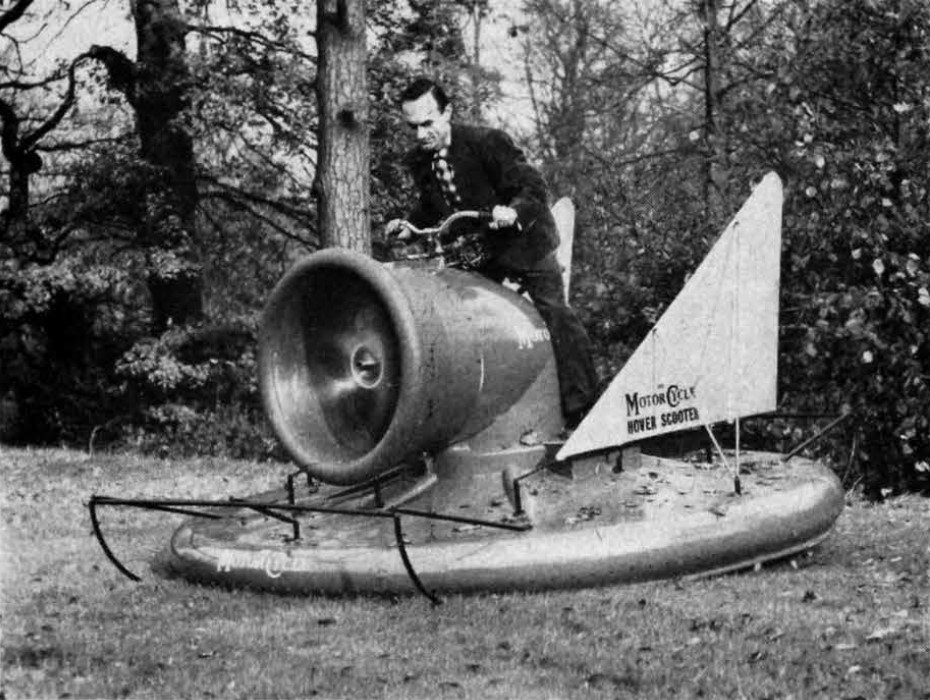
Innovation was in short supply at the 1960 Cycle and Motor Cycle Show, but The Engineer managed to track down an exhibit from the West Midlands that passed muster and one from the US that continues to enthral to this day.
Held at Earls Court in London and opened by transport minister Ernest Marple, the show was held to celebrate the Golden Jubilee the defunct British Cycle and Motor Cycle Industries Association.
Despite the occasion, The Engineer’s reporter said ‘the exhibits include few innovations among cycles and motorcycles in the strictest senses of the terms’, although a Hover Scooter brought to the UK by Rhoades Incorporated did appear to be worthy of a mention.
The American invention combined a hovercraft with a scooter powered by a 250cc twin cylinder 2-stroke motorcycle engine.
“Its relationship to a cycle is that it is steered in the corresponding way by developing bank, although the rider’s movement is exactly the opposite, i.e. to tighten a turn he leans out on a cycle and in on a Hover Scooter,” The Engineer said. “Having no wheels, the cushion-rider has no stability in yaw at other than high speeds, when the tail fins become effective, and so a yaw control is provided.”
This, The Engineer noted, was achieved by fitting 116 small vanes in the annular jet and connecting the vanes which were joined by a cable running round the jet to a pair of handlebars.
READ THE ORIGINAL ARTICLE HERE
“Movement of the bars deflects the blades and gives the jet sheet a helical motion; no change in the magnitude of the lift developed can be detected,” The Engineer said. “The machine has a 250cc, twin-cylinder, two stroke Yamaha engine driving the forward-facing fan; the weight of the engine is naturally proportionately high in such a small ground effect machine, and so particular attention has been given to the efficiency of the air ducts… the internal passages have been shaped to avoid losses due to severe expansions, and in addition a flexible fabric curtain has been fitted which gives some economy in power by reducing the minimum height necessary for moving over an irregular surface.”
At first glance the Hover Scooter bears some resemblance to Christopher Cockerell’s hovercraft concept, but any suspicions of IP infringement were allayed when it was pointed out that ‘the principles on which it is based were demonstrated in the United States in 1953 by N.A.C.A. (now N.A.S.A.) and at the US Navy Taylor Basin.’
The Rhoades vehicle was to be marketed in the UK by Autohall (Car Hire), Ltd, a company that in 1965 found itself in the national press for all the wrong reasons when one of its cars was hired to help Great Train Robber Ronald Biggs and three others escape from Wandsworth Prison.
Whilst perhaps something of a novelty, the idea that a scooter or motorbike can float or fly refuses to go away as was seen at the turn of 2020 when French company Lazareth introduced a motorbike that becomes a hover cycle when the vehicle’s wheels change function and become rotors.
Back at the Cycle and Motor Cycle Show, The Engineer was taken with an innovation emanating from the very heart of Britain’s motorcycling industry,
Making its first public appearance was the far more conventional Velocette Viceroy scooter from Birmingham’s Veloce Ltd, a company that produced, with its shaft-drive ‘LE’, one of the first modern unit-construction machines built in this country.
“For an open-frame design, however, the firm once again adopted an unconventional solution and on the Viceroy the engine and transmission are separated by a propeller shaft running under the footboard,” The Engineer noted. “The advantages of this configuration are a more nearly optimum weight distribution, the ability to get at the engine without removing any cowlings - the sparking plugs are beneath plastic covers just in front of the footboards - and the fact that no cooling fan is needed.”
The engine itself was also unconventional, our reporter observed. “Like all the other small Velocette engines, it is a horizontally opposed twin, but, on the presumption that the scooter is accorded less utilisation than a conventional motor-cycle and therefore initial costs compare more heavily with running costs, it is a two-stroke. Clearly, a two-stroke twin of this configuration has the same firing frequency as a single, and the substitution of an unbalanced couple for an unbalanced force is the only advantage.”
An apparent disadvantage of such an engine, The Engineer surmised, is that unloading of one cylinder by a blocked port will overload the other and possibly pass unobserved.
“It has as high a cranking torque as a single and a geared starter is used instead of a dynamotor, but the maker believes that the combined unit, removal of which prevents the engine being run, is too costly in maintenance effort,” our reporter said. ”




Hard hat mounted air curtain adds layer of protection
Something similar was used by miners decades ago!